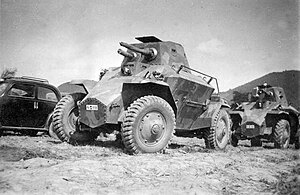
Summary
The 39M Csaba (t͡ʃɒbɒ) was a Hungarian armoured car designed by Nicholas Straussler. It was produced for the Royal Hungarian Army during World War II and used extensively on the Eastern Front fighting against the Soviet Union.
| 39M Csaba | |
|---|---|
 39M Csaba armoured scout car (1940) | |
| Type | Armoured car |
| Place of origin | Kingdom of Hungary |
| Service history | |
| In service | 1939 - 1945 |
| Used by | Hungarian Army |
| Wars | Second World War |
| Production history | |
| Designer | Nicholas Straussler |
| Designed | 1930s |
| Manufacturer | Weiss Manfred, Csepel |
| Produced | 1939 - 1944 |
| No. built | 102-137 |
| Specifications | |
| Mass | 5.95 tonnes |
| Length | 14 ft 8 in (4.52 m) |
| Width | 6 ft 10 in (2.1 m) |
| Height | 7 ft 4 in (2.27 m) |
| Crew | 3 |
| Armour | 9 mm |
Main armament | 1 × 20 mm Solothurn 36M anti-tank cannon |
Secondary armament | 1 × 8 mm Gebauer 1934/37M coaxial machine gun 1 × 8 mm detachable Solothurn light machine gun |
| Engine | Ford, 8-cylinder 90 hp |
Operational range | 93 mi (150 km) |
| Maximum speed | 65-85 km/h (40-53 mph)[1] |
Development edit
Hungarian expatriate Nicholas Straussler designed several armoured cars for Britain while living there between the two world wars. Straussler came to an agreement with the Weiss Manfred factory of Csepel, Budapest to produce vehicles from his designs for use in his home country – the most prominent was the Csaba (named after the son of Attila the Hun) which was designed based on his experience of the Alvis AC2 armoured car.
After successful trials in 1939, the Hungarian Army placed an order for 61, and a further order for an additional 40 vehicles was placed in 1940. Of these, twenty were used as actual fighting vehicles, with the remainder serving as armoured command cars and reconnaissance vehicles.
The Csaba had a 20 mm Solothurn anti-tank cannon[2] and a coaxial 8 mm Gebauer 1934/37M machine gun fixed on a centrally mounted turret, with 9 mm armoured plating. The 20 mm cannon had 200 shells in 5 shell capacity magazines, for a total of 40 magazines, meanwhile the coaxial 8 mm Gebauer machine gun had 3000 rounds in 100 round metal belts.[3] The vehicle was also equipped with a detachable 8 mm Solothurn light machine gun fired through the rear hatch in the anti-aircraft role. The crew could dismount and carry this LMG when conducting reconnaissance on foot. It also had two driving positions – one at the front as normal, and an additional one at the rear.
The 40M Csaba was a command version armed only with the turret-mounted 8 mm machine gun. This vehicle was fitted with a second R-4T radio, which had a large lattice radio mast.
Gallery edit
-
Front view of a 39M Csaba
-
Side view of a 39M Csaba
-
39M Csaba armoured cars in 1940
-
Interior of a 39M Csaba showing the coaxial Gebauer machine gun
-
Interior of a 39M Csaba from the driver's position
-
A 39M Csaba damaged by a landmine and with the turret covered in Serbia, 1941, during the Invasion of Yugoslavia
-
A 39M Csaba stuck in a ditch, 1940
-
A 39M Csaba driving at speed, 1943
References edit
Notes edit
- ^ Poór, István (1980). Harckocsik és páncélozott járművek típuskönyve. Budapest, HU: Zrínyi Kiadó. p. 154. ISBN 963-326-283-6.
- ^ Zaloga, Steven J. (2018). The Anti-Tank Rifle. Oxford, UK: Osprey Publishing. p. 22. ISBN 978-1-4728-1722-8.
- ^ Jacky 95 (12 April 2018). "Csaba armored cars". Hungarianmilitaryww2. Retrieved 8 February 2023.
{{cite web}}: CS1 maint: numeric names: authors list (link)
Bibliography edit
- J C M Probst. "Hungarian armour during WW2". Airfix Magazine (September 1976).
External links edit
- "Hungarian Tanks". Archived from the original on 24 August 2007. Retrieved 2 August 2007.
- "Hungarian Army in Russia". Archived from the original on 30 March 2005. Retrieved 2 August 2007.
- "WW2 in Color". Archived from the original on 30 September 2007. Retrieved 2 August 2007.


